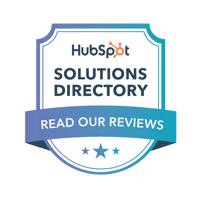Raise your hand if you like seeing ads on the web (or anywhere).
I can't actually see if you are raising your hand of course, but I'm going to guess you're not. (Or if you are, you work in advertising.)
Online advertising is an incredibly helpful tool for businesses to get found online, but it's also a tricky tactic to execute properly. Unfortunately, there are many, many (clickloads?) of examples of online advertising being used ineffectively or even dangerously.
The tide is changing: even huge ad-centric brands that relied on user tracking in ads are now pivoting to a user-first, privacy-centered online future. Overall, this move is positive for both advertisers and consumers. However, new rules and regulations mean that anyone who uses online ads needs to rethink their ad strategies.
In this article, I'll explore the current climate of cookieless targeting and how you can use this to your advantage to attract high-quality leads.
Key Terms
Before I go any further, let's review some of the key terms to know when discussing tracking and advertising.
Cookies - Pieces of user data from a website stored within a user's web browser. This can include anonymized data like location but also specific behavioral data (like past purchases) and, in some cases, personal data (like name, phone, or email).
Session cookies only store information while a user is visiting the site, and is deleted once the user leaves.
Persistent cookies/tracking cookies store user information for a longer period of time and historically stay active until a user takes an action like clearing their browser's cache. They have also historically been used in re-targeting advertising on sites like Facebook and Google to show users specific ads based on other websites they interact with.
First-party cookies are directly on a website that a user visits. This can also include a direct action, such as a user filling out a contact form and then later returning to a website, but it can also include more high-level data such as Google Analytics tracking the location of a visitor for demographic purposes, but not their identity.
Third-party cookies come from external content on a website. These historically were used in conjunction with third-party cookies. A classic example is searching for shoes online, and then browsing Facebook and suddenly seeing ads for shoe stores. Third-party cookies are the biggest privacy concern, and the abuse of this information is why major web browser vendors and mobile phones are going cookieless.
Zero-party data/explicit data - This is user data that a user directly and explicitly sends to a brand. The most common example is preferences for communication and/or products. This is often communicated via a form, quiz or other interactive element. This is also considered the best data from both a privacy and personalization perspective, as a user is proactively providing data in exchange for personalized content.
GDPR - The General Data Protection Regulation (GDPR) is a European Union law that governs how personal data is used, processed and stored. Regulations must be followed even by non-European companies if they do business in European markets. The most noticeable impact of GDPR is that brands must be transparent when they gather data, how it will be used and how long it will be stored. If you've browsed around online and seen a pop-up that informs you that the site uses cookies and asks you to accept or decline, that's to follow GDPR regulations. Many US brands proactively follow GDPR regulation even if they don't do business in Europe, to protect themselves in case a European user interacts with the site.
CCPA - The California Consumer Privacy Act (CCPA) is a similar law to GDPR. It applies to California residents and ultimately has the same impact as GDPR: California users must know when, how and why their data is being stored. This currently only applies to one state, but many other states are beginning to craft their own variations. For that reason, many brands are proactively following the regulations even if they don't currently do business with California citizens.

Why Are Cookies Disappearing?
For the most part, third-party cookies are being eliminated entirely by most browsers, while some first-party cookies are still allowed if they follow GDPR compliance. The move addresses privacy concerns. Historically, online advertisers have had virtually no oversight regarding user data. Cookies are neutral and are often used positively; but without regulations in place, it means they have a huge potential for privacy abuse. This has led to bad-faith actors abusing data by unethically tracking behavior, selling data and manipulating users. Users and legislators have become aware of this, and news stories, lawsuits and congressional hearings are pushing the issue.
In response, several high-profile companies like Apple, Firefox and Google have introduced privacy regulations that reduce or outright block cross-site tracking. This means that third-party cookies are or will be depreciated as a result. Google Chrome now turns tracking off by default for all users, and many other web browsers do the same.
Why Does Losing Third-Party Cookies Impact Advertising?
Many existing advertising platforms and best practices involve using third-party cookies to track users' behavior and retarget them through advertising. Losing that information means that advertisers need to rethink how they advertise online to consumers.
Don't think of the loss of third-party cookies as something bad—instead, it's an opportunity to move forward in a respectful, privacy-first approach that prioritizes your customers' safety and comfort.
Cookieless Targeting in Online Advertising
Cookieless advertising doesn't mean you lose the ability to target your ads. It just means that targeting looks a little different and that it puts the power into the hands of your users on how much information they want to share with you. This means you have to give them a reason to share this information, not just take it without permission.

1. Identify Your Audience and Their Journey
Losing third-party cookie data just stresses the importance of having a clearly defined audience(s) you want to attract. In today's online landscape, there's one thing I want you to remember:
A friend to all is a friend to none.
Advertising to every single person you can in the hopes that maybe, just maybe, they'll be a good fit is not effective or realistic online. Going down that route, you're likely to see a huge number of impressions or views, but no one actually takes action and turns into a customer.
Instead, you need to identify those who are your best fit and go after that audience through content, ads and online experiences that uniquely provide value to them. The best way to start is with strong buyer personas - these are semi-fictional representations of your ideal customers. A fleshed-out persona feels like a real person - they have a name, an age, a job, values and pain points. The strongest buyer personas are based on market research and insights you gather from your actual customer base.
Related Content: What is a Buyer Persona? (And How Do I Make One?)
From there, you can identify the buyer's journey that each persona takes. The buyer's journey follows 3 key steps:
- Awareness Stage: The buyer realizes they have a problem.
- Consideration Stage: The buyer defines their problem and researches options to solve it.
- Decision Stage: The buyer chooses a solution.
From all of this, you can create online ads that speak to your personas and their unique paths. Your ads can speak directly to your persona and their need at that point in time. Paired with Google advertising, this is an extremely effective way of finding web users who both fit your target and are more likely to engage with your ads.
2. Focus on Getting Users to Give You Their Data
With the shift away from third-party data, both first-party and zero-party data will be absolutely crucial. Your best overall option is to entice users with something so appealing that they'll willingly exchange their data to receive it. The simplest way to do this is through inbound marketing.
An inbound marketing campaign centers around a valuable piece of content (asset) and is supported by personalized experiences. For example, you might use an ebook, a quiz, a checklist or a webinar recording that speaks to your ideal customer at a specific point in their journey. The key here is creating the right asset - which goes back to doing persona work.
Related Content: How to Get Better Leads Through Better Inbound Marketing in 2024
Your inbound marketing asset ties back into advertising online. When you have a strong asset that your audience wants, then you can point your ads back to a landing page with a required form that users must fill out in order to access your asset. Once they've consensually given you their information, you can legally and ethically use that data to further market to them through other online ads and other marketing avenues such as email or social media.
Some examples of inbound marketing include...
- Take our hair quiz to find out what products are right for you
- Sign up for our upcoming webinar on SMS marketing
- Download our guide for planning a second story addition
- Access the latest research on direct mail effectiveness
The possibilities are endless - but the best inbound marketing assets are unique, specific and valuable.
The reason why inbound marketing works in a cookieless world is the consent factor. Filling out information on a form is an explicit opt-in on behalf of the consumer and in this case, your audience also will typically want to give their information so they can receive a personalized experience. Web users today are used to logging into websites and seeing content curated for them, instead of generalized information. You can use this predisposition to your advantage, to provide them the personalized experiences they want through smart content on your site (but that's another topic entirely!)
3. Use Contextual Advertising
Contextual advertising is the strategy of placing ads on websites based on the content of those pages. An example might be an ad for a home builder on a blog about bathroom design trends. This is different from behavioral advertising, which uses third-party cookies.
Again, this tactic emphasizes the importance of having clear personas to market against. When you know where your personas spend their time online and what information they're looking for, you can work with advertising providers that will place your ads contextually. One of the most effective ways to start is by using the Google Display Network.
The Google Display Networks works as an exchange between advertisers and websites. Advertisers define the topics and keywords they want to go after. In the remodeling example I used at the start of this section, the topics might include "Home Improvement" and keywords might include "best bathroom contractor." Websites in Google's display network are categorized by topics and related keywords. Google matches your topics with their topics and bam - you have a contextual ad placed on a relevant site.
Contextual ads serve two key benefits over randomly placed ads. First - it comes across as far less spammy to the audience browsing online since the ads are synced with the content they consume. And second - it's better targeted because you're placing these ads in front of a consumer who is primed to engage with that topic. Better targeting equals better-qualified leads that are more likely to convert.
Related Content: How to Adapt Your Content for Google's Search Generative Experience
4. Use Retargeting Ads Intelligently
Retargeting is the process of serving ads to previous visitors to your website. These ads are placed on websites external to your site, the most common is social media like Meta and YouTube. The old-school style of retargeting based on third-party data is no longer an option, and as I've discussed at length, it's not particularly effective nowadays anyway. However, that doesn't mean that you can't still use retargeting ads or that they aren't effective—just that you have to use them intelligently.
There are still quite a few ways to utilize retargeting without cookies. Meta developed event-based targeting (Aggregated Event Measurement) specifically in response to iOS 14 privacy updates, and Google ads also allows you to create retargeting ads that meet their privacy standards. The core difference here is that you'll need to rely on first-party data and zero-party data (as a refresher: that's people who visit your site and opt-in to cookies and people who directly give you their contact information, respectively).
The intelligent way to use retargeting is to support your inbound marketing campaigns. For example, you can create retargeting ads that push relevant retargeted ads to users who filled out a form to access your inbound campaign but haven't actually converted into a customer yet. This is one way to help keep your brand top of mind.
Final Thoughts
This new shift to privacy-first marketing is one that marketers and advertisers alike can use to find better-qualified leads. Advertising in a cookieless world is focused on specificity, transparency and reciprocity. User data is now a valuable commodity - in order to entice users to give you their precious data, you have to offer them something equally as valuable in exchange. But doing so will provide to you with more qualified users who are more likely to be in your target market and also looking for exactly your solution.
Free Download: Everything You Ever Wanted to Know About Inbound Campaigns
Content is critical, and the best way to create compelling content is by providing value. Inbound campaigns help you find, target, and convert your ideal audience. Click "get my eBook" below to learn how to create buzz-worthy Inbound campaigns that drive action.
BizzyWeb is a Minneapolis-based digital marketing and web design agency that helps companies get the high-quality leads they need to grow and thrive. Our tactics include inbound marketing, SEO, advertising, web design, content creation and sales automation. We are an accredited HubSpot Diamond Partner and we offer full-service HubSpot onboarding, enablement and strategy for new and current users.






